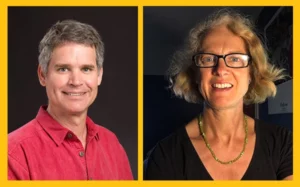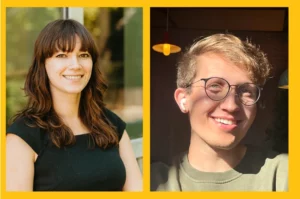Jillian Cervantes, who is graduating this month with a degree in mathematics, is described by her instructors as a talented mathematician and effective teacher. She also has ADHD.
She wasn’t diagnosed until adulthood, but when she was, the symptoms she’d experienced throughout her childhood suddenly made sense.
“There’s so much misinformation out there (about ADHD),” Cervantes said, “like, if you do well in school, then you don’t have ADHD or any disorder. I always did my homework because I was always stressed and anxious.”
To deal with her disability, Cervantes receives accommodations in her classes at UWM: She can ask her professors for extensions on assignments when needed, she is assigned extra time and a quiet room to take exams, she can study class material in advance, and she can use her iPad during class to record the instructor and take notes at the same time.
To combat the feelings of isolation that come with her disability, Cervantes found TAPDINTO-STEM.
TAPDINTO-STEM is a program through the National Science Foundation that creates social spaces and provides mentorship and funding for students with disabilities studying science, technology, engineering and mathematics (STEM) subjects. Founded in 2022, the TAPDINTO-STEM program at the University of Wisconsin-Milwaukee is now in its second year.
“I found out about TAPDINTO-STEM during my first semester receiving academic accommodations at UWM,” said Cervantes, a mathematical science major. “I was trying to figure out how to access my accommodations package and what it means to be a student with a disability, and I thought this would be a good way to meet other people.”
Cervantes added that that’s perhaps the greatest benefit of participating in the program: “She knows she’s not alone.”
Create a safe space
NSF has several programs aimed at increasing representation in STEM subjects under the umbrella of “National Inclusion of Underrepresented Discoverer Learner Communities in Engineering and Science” (INCLUDES). These focus on women and minorities, but about five years ago NSF added TAPDINTO-STEM to the list to support students with disabilities. Currently, 35 different institutions across the U.S. are part of the TAPDINTO-STEM program network, including UWM and Milwaukee Area Technical College.
 TAPDINTO-STEM advisors John Burgess and Erica Young are both professors of biological sciences.
TAPDINTO-STEM advisors John Burgess and Erica Young are both professors of biological sciences.
“The idea was to make room for students with disabilities in STEM subjects and change the culture of science programs to not just accommodate but welcome and support students with a range of disabilities,” said John Burgess, a professor of biological sciences. He and his wife, Erica Young, also a professor of biological sciences, brought the program to UWM’s campus. The mission is personal: The couple’s son has a disability, and Burgess’ sister also has a disability. They witnessed loved ones struggle with education and wanted to ease the path for others.
Of course, UWM’s Accessibility Resource Center is here to help students with disabilities find the accommodations they need to succeed at college, including assistance with physical limitations if a student has hearing loss or mobility issues, or assistance with invisible disabilities like dyslexia, ADHD or anxiety disorders.
TAPDINTO-STEM provides additional support and connections, Burgess said. STEM majors who receive support through ARC, like Cervantes, are encouraged to apply for the program at the beginning of the academic year. About 10 students meet once a month.
“I’ve had meetings where I’ve been close to tears because people are so open about their experiences,” Burgess says. “Real connections are formed.”
Burges and Young also aim to make TAPDINTO-STEM a conduit for information so their group can learn about resources available on campus, meet with people such as the UWM ARC director and UWM faculty with disabilities, and network with employers who can offer insight into accommodations to incorporate into hiring and onboarding practices.
“Some of our local banks are very interested in hiring people with disabilities because some students with various forms of autism have unique and valuable skills, including the ability to focus and pay attention much more acutely than other students,” Burgess noted.
In addition to students, TAPDINTO-STEM is also a way for Burgess and Young to spread disability awareness to UWM faculty, staff and administration. They are working to establish partnerships with student groups on campus, including the UWM chapter of DREAM (Disability Rights, Education, Activism, & Mentoring), a group of undergraduate students with disabilities. They also provide education for instructors and spread awareness about ARC’s Accessibility Certificate, offered in partnership with UWM’s Center for Teaching and Learning. While most faculty are understanding of students’ needs, some report that teachers have been skeptical of their accommodations.
“This is still a work in progress,” Young noted. “We’re thinking about how we can create a network of instructors and people who have experience understanding this that students can turn to for help.”
 Jillian Cervantes, a mathematical science major, and Benjamin Nelson, a biomedical science major, are both students with disabilities participating in UWM’s TAPDINTO-STEM program. Photo provided by Jillian Cervantes and Benjamin Nelson.
Jillian Cervantes, a mathematical science major, and Benjamin Nelson, a biomedical science major, are both students with disabilities participating in UWM’s TAPDINTO-STEM program. Photo provided by Jillian Cervantes and Benjamin Nelson.
Get profits
For biomedical sciences major Ben Nelson, TAPDINTO-STEM has not only been a source of community, but also a source of confidence. He has participated in the program for the past two years and plans to return next fall. He has type 1 diabetes and needs accommodations to safely monitor his blood sugar levels during class.
“We had a lot of great, non-judgmental discussions about what kind of experience we’re having at UWM and how we can change that experience, and that’s how empowering TAPDINTO-STEM is,” Nelson said. “Overall, it’s increased everyone’s confidence. It teaches us not to hide the fact that we have a disability. It teaches us not to avoid talking to instructors.”
Cervantes agreed.
“For me, it’s about knowing that there are people who are on my side. I feel very empowered in that respect,” she said.
She’s also grateful that students in the program receive scholarships because, she said, disabilities often make it hard for students to continue working and succeed in class, so it helps to have the extra support.
The program is also beneficial to the university, Burgess and Young argued: TAPDINTO-STEM and UWM’s Accessibility Resource Center are important tools for students and should play a larger role in recruiting new students, they said.
Because whatever a student’s disability may be, it shouldn’t stop them from achieving their academic dreams.
Sarah Vickery (Faculty of Arts and Sciences)

